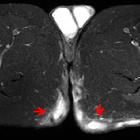Hidradenitis suppurativa











Hidradenitis suppurativa is an inflammatory skin disease of unknown cause. It has an autosomal dominant inheritance pattern, and androgen excess have been postulated. The disease is associated with Crohn disease and Dowling Degos disease.
Epidemiology
Up to 4% of the general population are affected to some degree (see Hurley Stages below). There is a significant female preponderance.
Clinical presentation
The disease affects areas bearing apocrine or sebaceous glands: groin, buttocks, inner thighs, axillae and under the breasts.
Hidradenitis suppurativa has three stages (Hurley stages) :
Pathology
Based on histological features, it is considered inflammatory and originating from the hair follicle; hence, the term 'acne inversa' is favored by some experts. The exact etiology is uncertain.
Risk factors
- smoking seems to be a major triggering factor
- obesity may aggravate the disease
Radiographic features
The diagnosis of hidradenitis suppurativa is clinical, and imaging is non-specific.
Ultrasound
A number of features can be identified by ultrasound. These features include both actual lesions and possible predisposing factors such as skin thickness and hair follicle morphology.
MRI
MRI is the test of choice to assess the extent and for complications. MRI is also useful to differentiate from Crohn disease , the main differential diagnosis.
STIR is considered the most useful sequence.
- marked thickening of the skin
- induration of the subcutaneous tissues
- formation of multiple subcutaneous abscesses
- prominent lymphadenopathy
The differential diagnosis for these findings includes carbuncles, lymphadenitis, and infected Bartholin's or sebaceous cysts. Sinus and fistula formation remote from rectum and anus (cf. Crohn disease) .
PET/CT
Focal intense FDG uptake in affected areas has been reported .
Treatment and prognosis
Management with antibiotics and other non-surgical interventions such as retinoids and corticosteroids may relieve early symptoms. Radical surgery (e.g. radical excision of all apocrine-bearing tissue) may be necessary for control and to prevent recurrence.
Siehe auch:


 Assoziationen und Differentialdiagnosen zu
Assoziationen und Differentialdiagnosen zu 